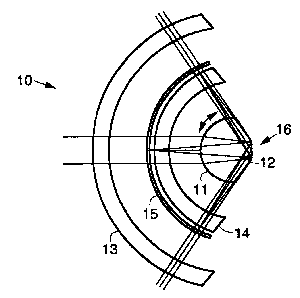Une partie des informations de ce site Web a été fournie par des sources externes. Le gouvernement du Canada n'assume aucune responsabilité concernant la précision, l'actualité ou la fiabilité des informations fournies par les sources externes. Les utilisateurs qui désirent employer cette information devraient consulter directement la source des informations. Le contenu fourni par les sources externes n'est pas assujetti aux exigences sur les langues officielles, la protection des renseignements personnels et l'accessibilité.
L'apparition de différences dans le texte et l'image des Revendications et de l'Abrégé dépend du moment auquel le document est publié. Les textes des Revendications et de l'Abrégé sont affichés :
| (12) Brevet: | (11) CA 2353433 |
|---|---|
| (54) Titre français: | CAPTEUR OPTIQUE DE BALAYAGE A LENTILLES CONCENTRIQUES, ET A TRES GRANDE LARGEUR DE CHAMP |
| (54) Titre anglais: | ULTRA-WIDE FIELD OF VIEW CONCENTRIC SCANNING SENSOR SYSTEM |
| Statut: | Périmé et au-delà du délai pour l’annulation |
| (51) Classification internationale des brevets (CIB): |
|
|---|---|
| (72) Inventeurs : |
|
| (73) Titulaires : |
|
| (71) Demandeurs : |
|
| (74) Agent: | MARKS & CLERK |
| (74) Co-agent: | |
| (45) Délivré: | 2003-12-23 |
| (86) Date de dépôt PCT: | 2000-10-05 |
| (87) Mise à la disponibilité du public: | 2001-04-12 |
| Requête d'examen: | 2001-06-01 |
| Licence disponible: | S.O. |
| Cédé au domaine public: | S.O. |
| (25) Langue des documents déposés: | Anglais |
| Traité de coopération en matière de brevets (PCT): | Oui |
|---|---|
| (86) Numéro de la demande PCT: | PCT/US2000/027476 |
| (87) Numéro de publication internationale PCT: | US2000027476 |
| (85) Entrée nationale: | 2001-06-01 |
| (30) Données de priorité de la demande: | ||||||
|---|---|---|---|---|---|---|
|
L'invention porte sur un capteur optique de balayage à lentilles concentriques très compact à grande ouverture numérique, à résolution élevée, et à très grande largeur de champ. Ledit capteur comporte une lentille hémisphérique de balayage présentant une surface arrière plane réfléchissante, des lentilles en coque extérieure et intérieure et une surface linéaire en réseau focalisée. Les lentilles coques sont disposées concentriquement par rapport au centre de la lentille hémisphérique de balayage, tandis que la surface linéaire en réseau l'est autour du centre de la lentille coque intérieure. Le capteur peut jouer le rôle d'une lentille sphérique à plusieurs surfaces réfléchissantes permettant un balayage à facettes.
A very compact, high numerical aperture, high resolution, ultra-wide field of
view concentric scanning optical sensor. The concentric scanning optical
sensor includes a scanning half ball lens having a flat reflective rear
surface, outer and inner shell lenses, and a linear focal surface array. The
outer shell lens and linear inner shell lens are concentrically disposed about
the center of the scanning half ball lens. The linear focal surface array is
disposed along a focal surface of the inner shell lens. The scanning optical
sensor may also use a full spherical ball with multiple reflecting surfaces to
allow for multiple facet scanning.
Note : Les revendications sont présentées dans la langue officielle dans laquelle elles ont été soumises.
Note : Les descriptions sont présentées dans la langue officielle dans laquelle elles ont été soumises.

2024-08-01 : Dans le cadre de la transition vers les Brevets de nouvelle génération (BNG), la base de données sur les brevets canadiens (BDBC) contient désormais un Historique d'événement plus détaillé, qui reproduit le Journal des événements de notre nouvelle solution interne.
Veuillez noter que les événements débutant par « Inactive : » se réfèrent à des événements qui ne sont plus utilisés dans notre nouvelle solution interne.
Pour une meilleure compréhension de l'état de la demande ou brevet qui figure sur cette page, la rubrique Mise en garde , et les descriptions de Brevet , Historique d'événement , Taxes périodiques et Historique des paiements devraient être consultées.
| Description | Date |
|---|---|
| Représentant commun nommé | 2019-10-30 |
| Représentant commun nommé | 2019-10-30 |
| Le délai pour l'annulation est expiré | 2019-10-07 |
| Lettre envoyée | 2018-10-05 |
| Accordé par délivrance | 2003-12-23 |
| Inactive : Page couverture publiée | 2003-12-22 |
| Préoctroi | 2003-10-03 |
| Inactive : Taxe finale reçue | 2003-10-03 |
| Un avis d'acceptation est envoyé | 2003-04-11 |
| Un avis d'acceptation est envoyé | 2003-04-11 |
| month | 2003-04-11 |
| Lettre envoyée | 2003-04-11 |
| Inactive : Approuvée aux fins d'acceptation (AFA) | 2003-03-28 |
| Modification reçue - modification volontaire | 2002-02-07 |
| Inactive : Page couverture publiée | 2001-09-28 |
| Modification reçue - modification volontaire | 2001-09-14 |
| Inactive : CIB en 1re position | 2001-09-06 |
| Inactive : Acc. récept. de l'entrée phase nat. - RE | 2001-08-13 |
| Lettre envoyée | 2001-08-13 |
| Demande reçue - PCT | 2001-08-10 |
| Toutes les exigences pour l'examen - jugée conforme | 2001-06-01 |
| Exigences pour une requête d'examen - jugée conforme | 2001-06-01 |
| Demande publiée (accessible au public) | 2001-04-12 |
Il n'y a pas d'historique d'abandonnement
Le dernier paiement a été reçu le 2003-09-23
Avis : Si le paiement en totalité n'a pas été reçu au plus tard à la date indiquée, une taxe supplémentaire peut être imposée, soit une des taxes suivantes :
Les taxes sur les brevets sont ajustées au 1er janvier de chaque année. Les montants ci-dessus sont les montants actuels s'ils sont reçus au plus tard le 31 décembre de l'année en cours.
Veuillez vous référer à la page web des
taxes sur les brevets
de l'OPIC pour voir tous les montants actuels des taxes.
Les titulaires actuels et antérieures au dossier sont affichés en ordre alphabétique.
| Titulaires actuels au dossier |
|---|
| RAYTHEON COMPANY |
| Titulaires antérieures au dossier |
|---|
| CHUNGTE W. CHEN |
| J. STEVE ANDERSON |